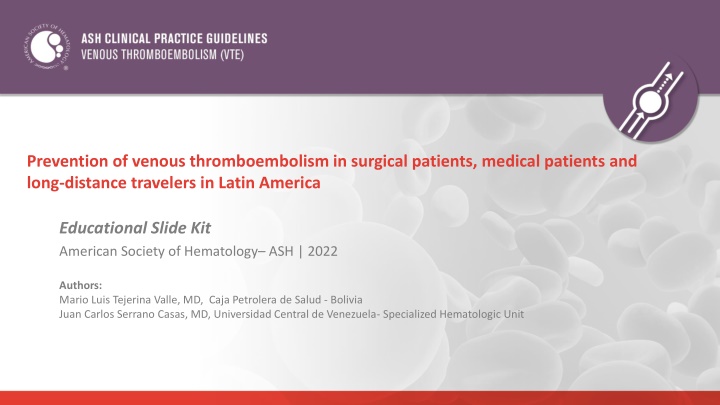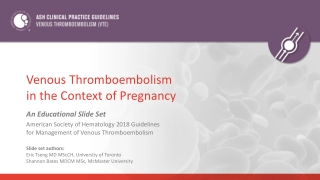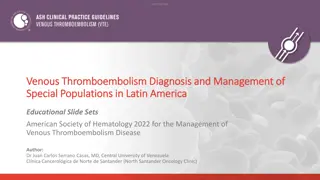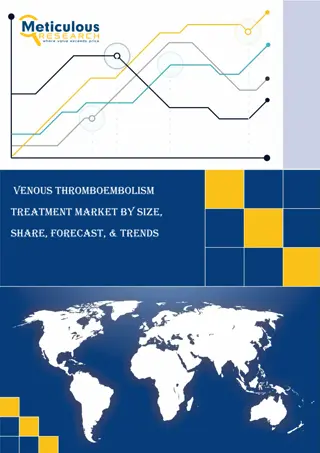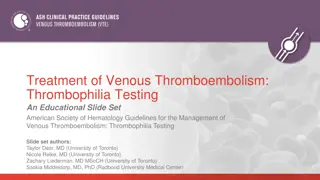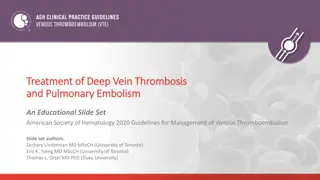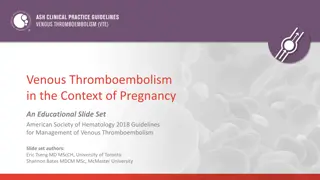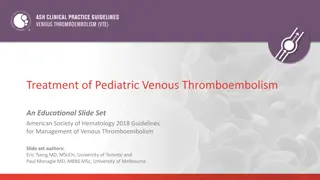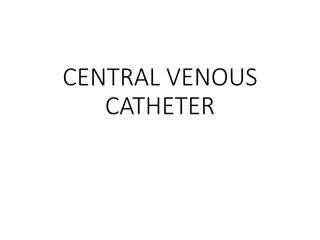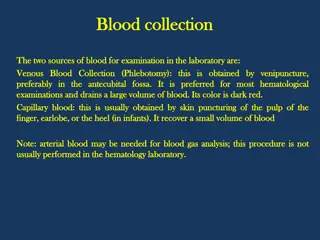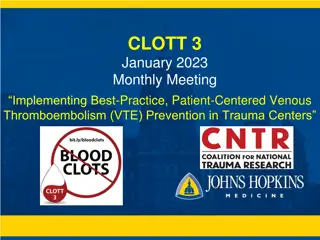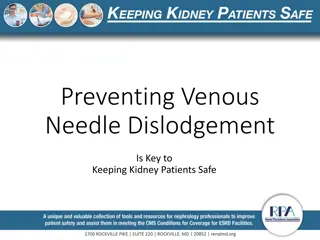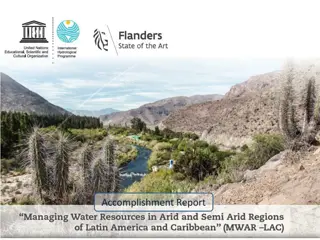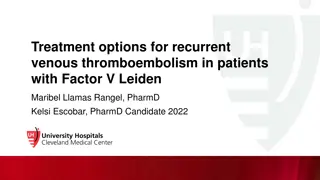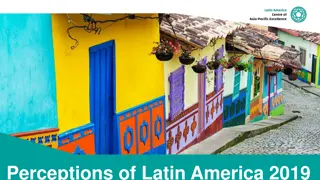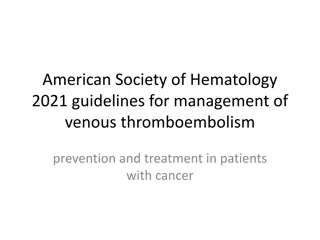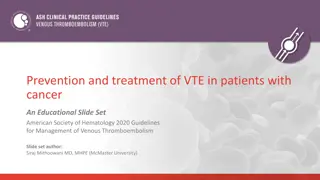Prevention of Venous Thromboembolism in Latin America
The Latin American ADOLOPMENT project focuses on preventing venous thromboembolism in surgical, medical patients, and long-distance travelers. A collaborative effort by various hematology societies, it emphasizes evidence-based recommendations for the region. The guidelines outlined in the project aim to enhance thromboembolism prevention strategies tailored to the Latin American context.
Download Presentation

Please find below an Image/Link to download the presentation.
The content on the website is provided AS IS for your information and personal use only. It may not be sold, licensed, or shared on other websites without obtaining consent from the author.If you encounter any issues during the download, it is possible that the publisher has removed the file from their server.
You are allowed to download the files provided on this website for personal or commercial use, subject to the condition that they are used lawfully. All files are the property of their respective owners.
The content on the website is provided AS IS for your information and personal use only. It may not be sold, licensed, or shared on other websites without obtaining consent from the author.
E N D
Presentation Transcript
Prevention of venous thromboembolism in surgical patients, medical patients and long-distance travelers in Latin America Educational Slide Kit American Society of Hematology ASH | 2022 Authors: Mario Luis Tejerina Valle, MD, Caja Petrolera de Salud - Bolivia Juan Carlos Serrano Casas, MD, Universidad Central de Venezuela- Specialized Hematologic Unit
Guidelines 2022 for the prevention of venous thromboembolism in surgical patients, medical patients and long-distance travelers in Latin America Ignacio Neumann, Ariel Izcovich, Ricardo Aguilar, Guillermo Le n Basantes, Patricia Casais, Cecilia Colorio, Cecilia Guillermo, Pedro Garcia Lazaro, Jaime Pereira, Luis Meillon, Suely Meireles Rezende, Juan Carlos Serrano, Mario Luis Tejerina Valle, Felipe Vera, Lorena Karzulovic, Gabriel Rada, Holger Schunemann. Neumann I, Izcovich A, Aguilar R, et al. ASH, ABHH, ACHO, Grupo CAHT, Grupo CLAHT, SAH, SBHH, SHU, SOCHIHEM, SOMETH, Sociedad Paname a de Hematolog a, SPH, and SVH 2022 guidelines for prevention of venous thromboembolism in surgical and medical patients and long-distance travelers in Latin America. Blood Adv. doi: 10.1182/bloodadvances.2021006482.
Latin American ADOLOPMENT project The Latin American ADOLOPMENT project is a pilot collaborative effort of the following institutions Sociedad Argentina de Hematolog a (SAH) Cecilia Colorio, MD Sociedad Boliviana de Hematolog a y Hemoterapia (SBHH) Mario Luis Tejerina Valle, MD Associa o Brasileira de Hematologia, Hemoterapia e Terapia Celular (ABHH) Suely Meireles Rezende, MD PhD Sociedad Chilena de Hematolog a Jaime Pereira, MD Sociedad Peruana de Hematolog a (SPH) Pedro Garc a L zaro, MD Sociedad de Hematolog a del Uruguay (SHU) Cecilia Guillermo, MD Sociedad Venezolana de Hematolog a (SVH) Juan Carlos Serrano, MD Grupo Cooperativo Latinoamericano de Hemostasis y Trombosis (CLAHT) Patricia Casais, MD Asociaci n Mexicana de Hematolog a Luis Meillon MD Asociaci n Colombiana de Hematolog a y Oncolog a Guillermo Basantes MD American Society of Hematology MacGRADE Center GRADE-ADOLOPMENT is an explicit and systematic method for adopting, adapting or developing evidence- based recommendations from existing recommendation developed using the GRADE approach. GRADE Evidence to Decision frameworks for adoption, adaptation, and de novo development of trustworthy recommendations: GRADE-ADOLOPMENT (J Clin Epidemiol. 2017 Jan; 81:101-110).
ASH Clinical Practice Guidelines on VTE 1. 2. 3. 4. 5. 6. 7. 8. 9. 10. VTE diagnosis Prevention of VTE in hospitalized surgical patients Prevention of VTE in hospitalized patients Treatment of acute VTE (DVT and PE) Optimal management of anticoagulation therapy Prevention and treatment of VTE in cancer patients Heparin-Induced Thrombocytopenia (HIT) Thrombophilia Pediatric VTE VTE in pregnancy
How were the ASH guidelines developed? PANEL COMPOSITION Each panel was formed according to key criteria: Balance in expertise (including disciplines beyond hematology and patients). Attention to minimization and management of COI CLINICAL QUESTIONS 10 to 20 clinically relevant questions generated in PICO format (population, intervention, comparison, and outcome). EVIDENCE SYNTHESIS Analysis of the evidence for each PICO question x systematic review of outcomes: Desirable and undesirable outcomes Resource use Feasibility Acceptability Accessibility Patient values and preferences DRAFTING OF RECOMMENDATIONS Recommendations made by panel members based on evidence from all contributing factors. EXAMPLE OF A PICO* QUESTION Should we use thromboprophylaxis in patients undergoing major neurosurgical procedures? *PICO Questions: Patients/Population, Intervention/Indicator, Compare/control, Outcome ASH guidelines are reviewed annually by expert work groups convened by ASH. Resources, such as this slide set, derived from guidelines that require updating are removed from the ASH website.
How should patients and physicians use these guidelines? STRONG Recommendation ("The panel recommends...") CONDITIONAL Recommendation ("The panel suggests...") Most individuals will want the intervention. Most individuals will want the intervention, but many will not. For patients Different options will be appropriate for different patients, depending on their values and preferences. Use shared decision making. For physicians Most individuals should receive the intervention.
General Objectives 1. Establish models of thromboprophylaxis in surgical patients in terms of indication, type of prophylaxis, starting phase and duration of prophylaxis. 2. Evaluation of the use of antithrombotic prophylaxis in medical patients with indication, type of pharmacological agent, role of mechanical prophylaxis, duration of prophylaxis. 3. Thromboprophylaxis guidance in short and long-distance travelers.
What are the relevant aspects in this chapter? IN SURGERY Surgery causes 25% of VTE in the community, even with current prophylaxis strategies, with risk varying according to the procedure (e.g.: orthopedics, neurosurgery, CCV). Post-surgicalVTE can often occur at discharge and can cause up to 50,000 deaths per year in the United States.
In Surgery Main modalities for postoperative VTE prevention Pharmacological prophylaxis Anticoagulants (LMWH, UFH, OACD, vitamin K antagonists) Antiplatelet agents (ASA) Mechanical prophylaxis Graduated compression stockings Intermittent pneumatic compression devices IVC filters
Which clinical outcome was most relevant to the panel's decision making? Less emphasis on asymptomatic DVT events (detected in screening studies). Mortality Symptomatic VTE, AE, proximal DVT, severe distal DVT Major bleeding Re-intervention If symptomatic events are not distinguishable from asymptomatic events, clinical model analysis should be carried out to assess VTE cases that may require treatment.
Case 1: Acute Surgical Abdomen Male patient 65 years old, weight loss of 10 kg, with pain in the left iliac fossa in the last week, abdominal distension, constipation, vomiting. In abdominal CT study there is LOE in descending colon. In colonoscopy Bx is identified with colon adenocarcinoma. Background: Obesity, AHT with mild nephropathy. Medication: Losartan 50 mg/day, ASA 100 mg/day. Idx: Intestinal Obstruction, Colon adenocarcinoma Caprini score: very high risk Proposed surgery: Sigmoid Colon Hemicolectomy, surgery time more than 45 min.
Considering his clinical condition as having a high risk of thrombosis in an oncologic patient surgery, what would be your recommendation? a) I would not administer thromboprophylaxis. b) I would only provide mechanical thromboprophylaxis. c) I would administer pharmacologic thromboprophylaxis d) I would administer thromboprophylaxis during hospitalization only
Should pharmacological prophylaxis be used or not in patients undergoing general surgery? RECOMMENDATIONS In patients undergoing general surgery, the Latin American panel suggests thromboprophylaxis rather than no thromboprophylaxis (conditional recommendation based on low certainty arising from the evidence provided by the Low quality evidence, so benefit/harm is uncertain. The panel also considered : The panel considered that in cases undergoing major surgery with an average risk of bleeding, pharmacologic or mechanical prophylaxis are reasonable alternatives. However, pharmacological prophylaxis is likely to be easier to implement. Clinical models (e.g. Caprini) are very useful but careful individualization of each case should be the norm. effects). Anticipated absolute effects (95% CI) Outcomes ( Quality of Evidence) Relative risk (95% CI) Risk without prophylaxis Risk with prophylaxis RR 0.75 (0.61 to 0.93) 4 fewer per 1000 (from 7 fewer to 1 fewer) Mortality 6 per 1000 RR 0.48 (0.26 to 0.88) 0 fewer per 1000 (from 0 fewer to 0 fewer) 6 fewer per 1000 (from 8 fewer to 1 fewer) AE Proximal symptomatic DVT RR 0.38 (0.14 to 1.00) 0 fewer per 1000 (from 0 fewer to 0 fewer) 7 fewer per 1000 (from 10 fewer to 0 fewer) RR 1.24 (0.87 to 1.77) 6 more per 1000 (from 3 fewer to 20 more) Major Bleeding Not available Quality of evidence (GRADE): Low Moderate Strong
Case 1: Acute Surgical Abdomen cont. The patient was successfully taken to surgery with 200 cc bleeding, he is in his first postoperative hours, thromboprophylaxis with enoxaparin is scheduled to be started; the clinical group asks when it will begin and for how long it will be administered.
Should early prophylaxis or delayed prophylaxis be administered in patients for whom pharmacological thromboprophylaxis is the preferred option? RECOMMENDATIONS Low quality evidence, so benefit/harm is uncertain. The panel also considered : In patients for whom pharmacologic thromboprophylaxis is the preferred option, the Latin American panel suggests delayed prophylaxis (12 hours after surgery), rather than early administration (before surgery). (Conditional recommendation based on very low certainty arising from the evidence provided by the effects). The starting time should be assessed individually with the surgical team, taking into account the risks of venous thromboembolism and bleeding. Patients requiring hospitalization for a period prior to surgery may benefit from prophylaxis. Anticipated absolute effects (95% CI) Outcomes (Quality of Evidence) Relative risk (95% CI) Early prophylaxis Delayed prophylaxis RR 0.75 (0.61 to 0.93) 4 fewer per 1000 (from 7 fewer to 1 fewer) Mortality 6 per 1000 RR 0.48 (0.26 to 0.88) 0 fewer per 1000 (from 0 fewer to 0 fewer) 6 fewer per 1000 (from 8 fewer to 1 fewer AE 7 fewer per 1000 (from 10 fewer to 0 fewer) ) Proximal symptomatic DVT RR 0.38 (0.14 to 1.00) 0 fewer per 1000 (from 0 fewer to 0 fewer) RR 1.24 (0.87 to 1.77) 6 more per 1000 (from 3 fewer to 20 more) Major Bleeding Not available Quality of Evidence(GRADE): Low Moderate Strong
Rationale This recommendation changed directions. The original guideline panel made a recommendation in favor of either alternative: early administration or delayed prophylaxis. The Latin American panel considered that for most patients undergoing general surgery, the risk of VTE before the procedure was very small. The use of early prophylaxis may slightly increase the risk of bleeding during surgery, adds to costs, and may be inconvenient for surgical teams.
Should an extended or a standard course of antithrombotic prophylaxis be used in patients for whom Should an extended or a standard course of antithrombotic prophylaxis be used in patients for whom pharmacological prophylaxis is the preferred treatment? pharmacological prophylaxis is the preferred treatment? Recommendation Where pharmacological prophylaxis is preferred, the Latin American panel suggests a short course (7 to 10 days) rather than an extended course (30 days) for surgical patients for whom thromboprophylaxis is the favored choice. (conditional recommendation based on very low certainty arising from the evidence provided by the effects). Remarks: In patients with an average risk of thromboembolism, a short course of prophylaxis will be more than sufficient. However, patients with cancer or undergoing orthopedic surgery may benefit from an extended course of thromboprophylaxis (4 weeks).
Extended LMWH thromboprophylaxis after major abdominopelvic cancer surgery was associated with a reduced incidence of clinical VTE without a clinically relevant increase in bleeding. Extended thromboprophylaxis following major abdominal/pelvic cancer-related surgery: A systematic review and meta-analysis of the literature Knoll W, Fergusson N, Ivankovic V et al Thrombosis Research 204 (2021) 114 122
Case 1 continued After one week of thromboprophylaxis the patient develops upper gastrointestinal bleeding, and the enoxaparin is discontinued; what course of action would you take? A. I would stop all thromboprophylaxis. B. I would wait 5 days and restart pharmacological thromboprophylaxis. C. I would use only elastic compression stockings D. I would use only intermittent pneumatic compression E. I would use both compression stockings and intermittent pneumatic compression, depending on availability
Should pneumatic compression prophylaxis or graduated compression stockings be used in patients for whom mechanical thromboprophylaxis is preferred? In patients for whom mechanical thromboprophylaxis is preferred, the Latin American panel suggests mechanical compression devices in lieu of graduated compression stockings (conditional recommendation based on low certainty arising from the evidence provided by the effects). Anticipated absolute effects (95% CI) Remarks Pneumatic compression devices are not available in all health centers in Latin America. The difference between mechanical devices and compression stockings is probably small; therefore, compression stockings are a reasonable alternative for patients for whom mechanical prophylaxis is preferred and there is limited availability of compression devices. Outcomes (Quality of Evidence) Relative risk (95% CI) Intermittent pneumatic compression Compression stockings RR 1.04 (0.16 to 6.63) 2 fewer per 1000 (from 41fewer to 274 more) 2 more per 1000 (from 46 fewer to 310 more) Mortality 0 fewer per 1000 (from 0 fewer to 0 more) 7 fewer per 1000 (from 14 fewer to 14 more) RR 0.56 (0.17 to 1.86) AE Proximal RR 0.48 (0.25 to 0.92 26 fewer per1000 (from 37 fewer to 4 fewer 0 fewer per1000 (from 0 fewer to 0 fewer) symptomatic DVT (any) Distal RR 0.55 (0.25 to 1.22) 0 fewer per 1000 (from 0 fewer to 0 fewer) 66 fewer per1000 (from 111 fewer to 33 more) symptomatic DVT (any) This recommendation did not change its direction or strength. Quality of Evidence (GRADE): Low Moderate Strong
Other specific recommendations Surgery The panel Recommends ( Number Rec ) Remarks or Rationale Patients with moderate or low risk of bleeding can be treated with pharmacological prophylaxis; for patients with high bleeding risk, mechanical prophylaxis may be a better option. Surgery following major trauma Thromboprophylaxis over no prophylaxis (2) Transurethral resection or radical prostatectomy may have a higher risk of bleeding than the average surgical patient (benign cases) with low risk of VTE, cancer or previous VTE that would require mechanical prophylaxis. Prostate Surgery Against thromboprophylaxis (4 and 5 ) Laparoscopic Cholecystectomy The panel suggests not to use pharmacological prophylaxis (3). Very low baseline risk of VTE. Specific high-risk groups (thrombophilia, prior VTE, cancer) may benefit. High risk of VTE and bleeding, when bleeding is high in the first days, mechanical prophylaxis is an option, once the risk of bleeding decreases, pharmacological prophylaxis can be used. Major neurosurgical surgery Thromboprophylaxis recommended versus no prophylaxis (6)
Thromboprophylaxis in hospitalized clinical patients Risk factors for PTE in the hospital include cancer, advanced age group, previous PTE, central catheterization, immobility. Half of all PTE events occur in surgical (24%) or critically ill (22%) patients. There is an increased risk of thrombosis in clinical patients that persists 45 to 60 days after hospital discharge. 40% of patients have 3 or more risk factors for PTE.
Which patients are at risk for PTE in the hospital? Risk Assessment Models (RAMs) can identify high risk patients Exemples: Padua, IMPROVE-VTE Scores Padua RAM: Factors IMPROVE-VTE RAM: Factors Previous PTE Thrombophilia Active cancer Age > 70 years Immobility Recent trauma/surgery Heart or respiratory failure AMI or CVA Hormonal treatment Obesity (BMI > 30) Infection/collagenosis Previous PTE Thrombophilia active cancer Age > 60 years Immobilization 7 days Leg paralysis UTI hospitalization These RAMs are not widely validated for guided decision making for prophylaxis. Spyropoulos Chest 2011 Leizorovicz Circulation 2004
Clinical Case 2: Hospitalized Medical Patient 72 years old male Medical history: COPD, hypertension, type 2 diabetes, obesity (BMI 41 kg/m2), PTE 15 years ago (minor orthopedic surgery). Medication: metformin, amlodipine, losartan, bronchodilator Admitted: Medicine Department with diagnosis of pneumonia. Treatment: antibiotics, oxygen therapy. Patient was admitted to the hospital due to significant deterioration of his general condition, with weakness, dyspnea and immobility. Curbs Index greater than 3 pts
Which of the following would you suggest as thromboprophylaxis during your hospital stay? A. Low Molecular Weight Heparin (LMWH) or UFH B. Direct oral anticoagulants ( Rivaroxaban, or Apixaban) C. Graduated compression stockings D. No prophylaxis because of low risk of thrombosis.
Risk factors for PTE in our patient. Padua RAM: Factors IMPROVE-VTE RAM: Factors Previous PTE Thrombophilia Active cancer Age > 60 years Immobilization 7 days Lower limb paralysis ICU admission Previous PTE Thrombophilia Active cancer age > 70 years Immobility Recent trauma/surgery Respiratory failure AMI or CVA Hormonal treatment Obesity (BMI > 30) Infection/colagenosis
Should Should unfractionated heparin or low molecular weight heparin unfractionated heparin or low molecular weight heparin be used in hospitalized patients with acute or critical illness requiring pharmacological prophylaxis? with acute or critical illness requiring pharmacological prophylaxis? be used in hospitalized patients Recommendation The Latin American panel suggests the use of either unfractionated heparin or low- molecular-weight heparin (conditional recommendation based on low certainty arising from the evidence provided by the effects). Remarks The difference between unfractionated heparin and low molecular weight heparin in venous thrombosis and bleeding events is very small. Unfractionated heparin may be a reasonable alternative in settings where the price of low molecular weight heparin is a problem. In situations where access to LMWH is not an issue, this option is a more convenient alternative for patients, physicians and providers. Anticipated absolute effects (95% CI) Relative effect: RR (95% CI) Outcomes Risk with UHF Risk with LMWH 1 fewer per 1,000 (9 fewer to 5 more) 0.99 1 fewer per 1000 (from 2 fewer to 5 more) Mortality (0.82 to 1.19) 1 fewer per 1000 (from 0 fewer to 0 more) 1 fewer per 1000 (from 4 fewer to 4 more) RR 0.82 (0.40 to 1.68 AE Proximal symptomatic DVT RR 0.80 (0.21 to 2.96) 0 fewer per 1000 (from 1 fewer to 4 more) 1 fewer per1000 (from 2 fewer to 5 more) 2 more per1000 (from 5 fewer to 3 more) RR 0.80 (0.48 to 1.31) Major bleeding This recommendation changed directions. The original panel made a conditional recommendation in favor of LMWH, but the Latin American panel made a conditional recommendation in favor of either. Quality of Evidence (GRADE): Low Moderate Strong
During the Specialist and resident review on the internal medicine floor, the possibility of, at some point, making the switch to the use of direct anticoagulant agents in this patient is discussed. Do you agree? NO YES
Recommendation Should low-molecular-weight heparin be used in preference to direct oral anticoagulant agents in patients with acute illness requiring pharmacological thromboprophylaxis? The Latin American panel suggests using low-molecular-weight heparin over direct oral anticoagulant agents in medical thromboprophylaxis (conditional recommendation based on moderate certainty arising from the evidence provided by the effects). Evidence from 3 trials showed that short course of LMWH vs short course and prolonged DOACs increase bleeding without significant impact on VTE reduction. Original panel gave strong recommendation against DOAC. (Absolute in bleeding is small: 0.2 to 1.2% . The Latin American panel considered that some patients may trade the small increase in bleeding for convenience of oral agent. A conditional recommendation was issued Any DOAC compared to prophylactic LMWH: Anticipated absolute effects (95% CI) Relative effect: RR (95% CI) Outcomes Risk with difference with any DOAC Risk with prophylactic LMWH 0 fewer deaths per 1,000 (1 fewer to 1 more) 0.64 Mortality 1 per 1,000 (0.21 to 1.98) 0 fewer AE per 1000 (1 fewer to 3 more) 1.01 0 fewer per 1000 (from 3 fewer to 10 more) AE (0.29 to 3.53) Proximal symptomatic DVT 0 fewer per 1000 (from 1 fewer to 2 more) 0 fewer per 1000 (from 1 fewer to 4 more) 1.03 (0.34 to 3.08) 2 bleedings more per 1000 (0 fewer to 4 more)* 1.70 8 more per 1000 (from 0 fewer to 22 more) Major bleeding (1.02 to 2.82) This recommendation changed strength vs original * These estimates apply to a low baseline bleeding risk. Quality of Evidence : Low Moderate Strong
The patient has recent gastrointestinal bleeding. You decide to discontinue thromboprophylaxis to ensure hemostasis. Which of the following options for thromboprophylaxis would you suggest at this time? A. Elastic Compression Stockings B. Pneumatic compression devices C. Calf exercises (physical therapy) D. No mechanical prophylaxis required E. Both Compression Stockings and Pneumatic Compression Devices are valid
Recommendation 14 In patients with acute and critical illness who cannot receive pharmacologic prophylaxis, the Latin American panel suggests the use of mechanical prophylaxis rather than no prophylaxis (conditional recommendation based on moderate certainty arising from the evidence provided by the effects). Recommendation 15 In hospitalized patients with acute and critical illness requiring mechanical prophylaxis, the Latin American panel suggests either of these two options: pneumatic compression devices or graduated compression stockings (conditional recommendation based on very low certainty arising from the evidence provided by the effects).
Recommendation 15 cont. Remarks The absolute differences between the two modalities in thrombotic events and bleeding are probably small. Final decision depends on cost, availability and physician- patient preference. Intermittent pressure devices are generally noisy and can disrupt sleep, and stockings exert continuous pressure that can be uncomfortable. Both modalities should be used according to the manufacturer's instructions.. Anticipated absolute effects (95% CI) Relative effect: RR (95% CI) Outcomes Risk with pneumatic compression Risk with elastic compression stockings RR 3.43 (0.15 to 79.74) 0 fewer deaths per 1,000 (0 fewer to 0 more) Mortality 1 per 1,000 1 fewer per 1000 (from 1 fewer to 8 more ) RR 0.38 (0.02 to 8.86) 27 fewer per 1000 (de 43 menos a 342 more) AE RR 0,16 (0,01 to 2,98) Proximal symptomatic DVT 110 fewer per 1000 (from 129 fewer to 258 more) 2 fewer per 1000 (from 2 fewer to 4 more) 110 fewer per 1000 (from 129 fewer to 258 more) Distal Symptomatic DVT RR 0.16 (0.01 to 2.98) 6 fewer per 1000 (from 7 fewer to 14 more) This recommendation did not change either recommendation or strength Quality of Evidence: Low Moderate Strong
The GI bleeding resolved and a few days later thromboprophylaxis with LMWH was restarted. The patient was hospitalized for 9 days and was discharged with pneumonia in the process of resolution. His usual medication was prescribed. Would you recommend discharge prophylaxis against PTE? A. Discontinue LMWH on the day of hospital discharge. B. Maintain LMWH for 3 weeks C. Change LMWH to DOAC, and continue DOAC for 3 weeks D. Graduated compression stockings for 3 weeks
What is the rationale for extending thromboprophylaxis beyond hospital discharge? Most in-hospital events occur outside the hospital, in the first month after discharge. The risk of PTE in medical patients is elevated even 45-60 days after discharge. The duration of inpatient prophylaxis is coordinated as the average length of hospital stay decreases. Huang Am J Med 2014 Cohen NEJM 2016 Cohen NEJM 2014 Goldhaber NEJM 2011
Recommendation Should thromboprophylaxis be used for a short course or for an extended one in patients with acute or critical illness requiring pharmacological prophylaxis? In patients with acute or critical illness, the panel recommends a short course of thromboprophylaxis in inpatients over an extended course (conditional recommendation, moderate certainty arising from evidence provided by the effects). REMARKS The panel considered that there was some uncertainty regarding baseline VTE risk. While for most patients the baseline risk of VTE is small. Extended prophylaxis will not result in significant benefit, there are some patients at increased baseline risk of VTE who maintain this risk after discharge, especially if they require rehabilitation and are unable to ambulate. Such patients may benefit from extended prophylaxis. Anticipated absolute effects (95% CI) Relative effect: RR (95% CI) Outcomes Difference in risk with extended prophylaxis RR 0.97 (0.87 to 1.08) 1 fewer per1000 (from 4 fewer to 3 more) Mortality RR 0,62 (0,39 to 0,99) 1 fewer per 1000 (from 2 fewer to 0 fewer) AE Proximal symptomatic DVT RR 0.77 (0.64 to 0.93) 6 fewer per 1000 (from 10 fewer to 2 fewer) RR 1.84 (1.33 to 2.55) 2 m s por 1000 (from 1 more to 4 more) Major Bleeding This recommendation changed its strength. The original panel made a strong recommendation in favor of short prophylaxis, while the Latin American panel made a conditional recommendation. Quality of Evidence (GRADE): Low Moderate Strong
CONSIDERATIONS Why is routine extended thromboprophylaxis not currently recommended? Extended thromboprophylaxis can reduce PE and DVT, but the absolute impact on PTE reduction is small (1 for 3 PTE per 1,000 treated patients) and is similar to the number of bleeding events caused. Extended prophylaxis has no impact on mortality. Possibly the three most important studies (APEX, MAGELLAN, ADOPT) did not select patients at sufficiently high risk of PTE. However, the MARINER trial (Spyropoulos NEJM 2018) also showed no significant reduction in PTE despite the use of the modified IMPROVE VTE risk score to select clinically high-risk patients using extended thromboprophylaxis with rivaroxaban.
"Among hospitalized medical patients, prolonged venous thromboprophylaxis was associated with a decreased risk of VTE events but an increased risk of bleeding with no significant difference in VTE- related death." Extended duration of thromboprophylaxis for medically ill patients: a systematic review and meta-analysis of randomised controlled trials Zayed Y, Kheiri B, Barbarawi M Internal Medicine Journal 50 (2020) 192 199
Clinical Case 3 Long distance travelers 53-year-old woman with a history of unprovoked DVT 4 years ago, obese BMI of 38 kg/m2. She is not on anticoagulant or antiplatelet medication. She has to travel by plane to Madrid, it will be a long flight (> 4 hours). Which of the following options would you recommend as an antithrombotic method? A. B. C. D. E. HBPM Graduated compression stockings Aspirin No prophylaxis needed A and B are correct
Air travel and DVT Long distance travel: 4 hours flight time or more Who is at elevated risk for VTE in travel? Air travel is associated with a 2.8 increased risk of developing PTE, which is proportional to the duration of the flight. Recent surgery Previous PET Postpartum women Active malignancy 2+ risk factors include the combination of the above with hormone replacement therapy, obesity, or pregnancy.
Recommendation In persons at increased risk for DVT, the panel suggests the use of graduated compression stockings or LMWH prophylaxis for long-distance travel (conditional recommendation based on very low certainty arising from evidence provided by the effects). In persons at low risk of DVT, the panel suggests NOT to use thromboprophylaxis (conditional recommendation based on very low certainty arising from the evidence provided by the effects). Relative Effects (RR, 95% CI) on VTE Prevention (compared with no intervention) Remarks LMWH, graded stockings and ASA have a small uncertain benefit. There is no evidence regarding the use of DOACs for in-flight thromboprophylaxis. Absolute Risk Difference with each intervention (compared with no prophylaxis) Intervention Graduated Compression Stockings 3 fewer PE per 1,000,000 (3 fewer to 3 fewer) 1.8 fewer asymptomatic DVT per 10,000 (1.9 fewer to 1.5 fewer) 0.10 (0.04 to 0.25) 3 fewer PE per 1,000,000 (3 fewer to 4 more) 17.8 fewer asymptomatic DVT per 10,000 (1.9 fewer to 2.2 more) 0.10 (0.10 to 2.11) LMWH 1 fewer PE per 1,000,000 (3 fewer to 12 more) 0.5 fewer asymptomatic DVT per 10,000 (1.7 fewer to 6.5 more) 0.75 (0.13 to 4.32) Aspirin
Applying these Guidelines to the patient: Why are these recommendations "conditional"? 53 years old female with previous unprovoked DVT and obesity. What is her risk of DVT associated to her risk factors when flying? Baseline annual risk 1 in 1,000 (age) x 2 (obesity) x 5 (prior VTE) 1 in 100 per year Daily VTE risk 1 in 100 x 1 in 365 days per year 1 in 3,650 VTE risk per flight 1 in 3,650 (daily risk) x 30 days of risk x 3 (RR with flight) 3% REMARKS What is the benefit of LMWH thromboprophylaxis? RR 0.10 (95% CI 0.01-2.11) compared with no intervention Approximate VTE risk per flight with LMWH = 3% x 0.10 = 0.3% (high uncertainty, 95% CI 0.03% to 6.3%) Graduated compression stockings, LMWH and aspirin have a small, uncertain effect on DVT prevention and the absolute benefit is very small. Physicians should take into account the patient's related risk factors. Eichinger Arch Int Med 2008 Silverstein Arch Int Med 1998
Case 3: Continued Given that the patient has a prior history of PTE and is obese, the indication for thromboprophylaxis with either graduated compression stockings or LMWH during her flight is warranted. She received thromboprophylaxis with LMWH in the morning for her 7-hour flight and did not develop DVT.
Summary Part 1: Returning to our objectives 1. Establish indication for thromboprophylaxis in surgical patients. - Use of prophylaxis in general surgery with moderate to high risk of DVT, in post-trauma surgery and in major neurological surgery. 2. Understand the use of mechanical prophylaxis and its types in surgery. - Patients with active or high risk of bleeding. Both options (elastic stockings and pneumatic compression are valid in our environment). 3. Beginning and duration of prophylaxis in surgery. - Late start prophylaxis is more widely accepted in Latin America. Prefer short duration prophylaxis in general surgery. Reserve extended prophylaxis for oncologic and orthopedic surgeries.
Summary Part 2: Returning to our objectives 1. To describe recommendations for thromboprophylaxis in inpatients with clinical or acute disease - Risk assessment models (RAMs), LMWH compared to DOACs 2. To describe the thromboprophylaxis recommendations for patients discharged from the hospital after acute illness - Extended prophylaxis versus in-hospital prophylaxis. LMWH compared to DOACs 3. To identify patients who may benefit from receiving thromboprophylaxis when traveling long distances - Graduated compression stockings or LMWH for those with strong risk factors for DVT.
Changes to the source recommendations The Latin American panel agreed on 21 recommendations. Compared to the original guideline, 6 recommendations changed direction and 4 changed strength. Four recommendations changed direction (recommendations 9, 10, 11 and 13) and two changed strength (12 and 16) because the Latin American panel considered that the small differences in the synthesis of evidence did not justify the resources needed to implement changes. There were concerns regarding access and the impact on health equity in some settings in the region. Two recommendations changed direction (2 and 6) because the Latin American panel considered additional indirect evidence from the effects of mechanical prophylaxis (the original panelists limited their recommendation to pharmacological prophylaxis). Two recommendations (18 and 19) changed in strength due to value and preference considerations. Latin American panelists placed more importance on how patients may value oral alternatives.
Acknowledgments ASH Latin American VTE Guidelines Panel team members ASH Team Members McMaster University GRADE Centre ASH VTE kit slide authors: Mario Luis Tejerina Valle, MD, Caja Petrolera de Salud - Bolivia Juan Carlos Serrano Casas, MD, Universidad Central de Venezuela Unidad Hematol gica Especializada More information on the ASH VTE Guidelines: www.hematology.org/VTE
